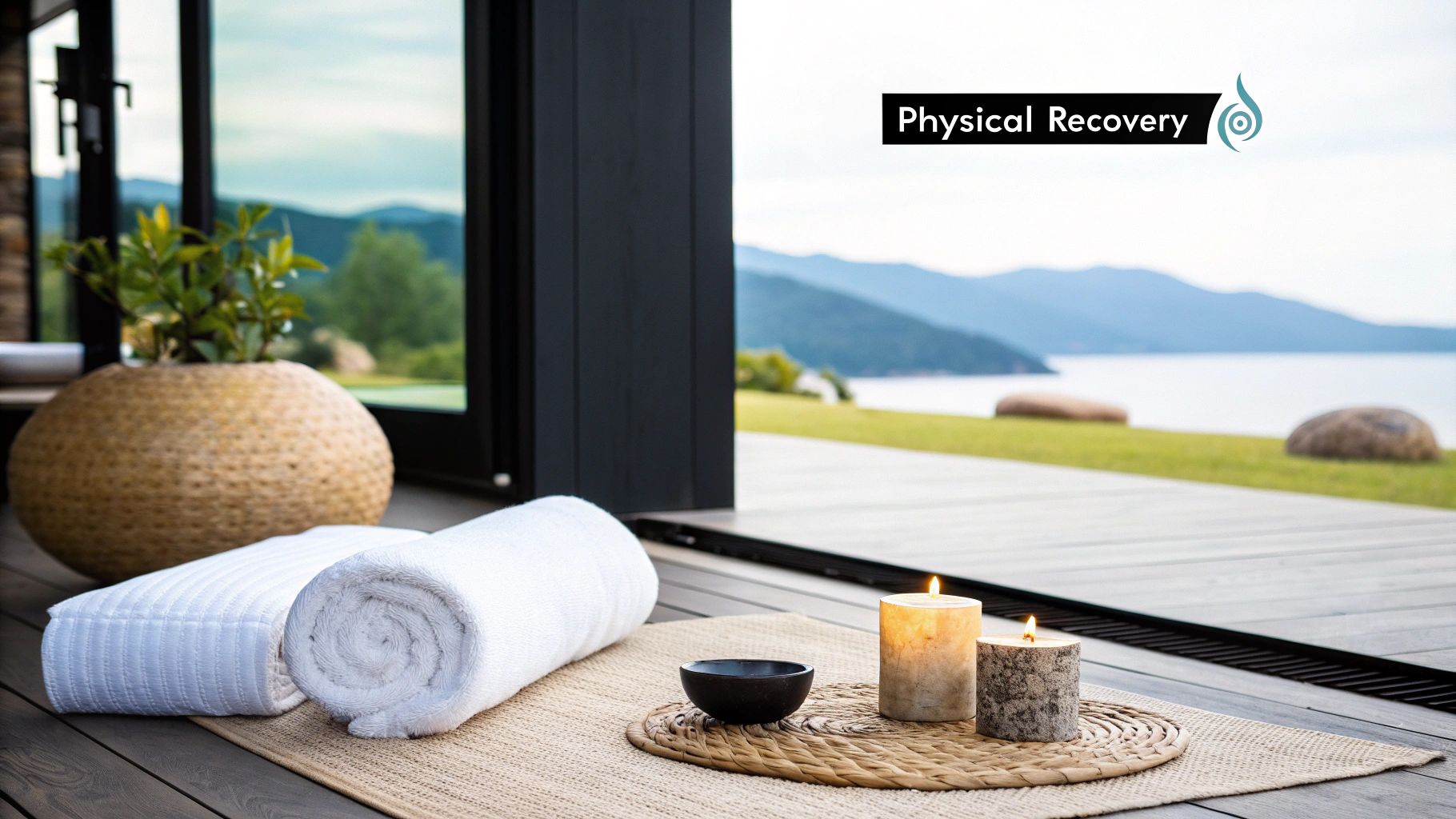Why After Sex Care Matters More Than You Think

Intimacy doesn’t end when the act of sex is over. The period following sex, known as after sex care, is equally important for both physical and emotional well-being. It’s a time to nurture the connection and build a stronger bond with your partner. Ignoring this crucial aspect can mean missing out on opportunities to deepen intimacy and trust.
Think of a beautiful house built on a shaky foundation. Over time, cracks will appear, and the structure could become unstable. Similarly, neglecting after sex care can create subtle issues in a relationship, potentially leading to insecurity and dissatisfaction. Prioritizing after sex care is an investment in the long-term health and happiness of your relationship.
Sexual aftercare, the period of caring for one another after sexual activity, plays a key role in fostering emotional connection and physical comfort. This might include cuddling, talking, or massage, all of which contribute to feelings of security and respect. Medical News Today highlights how sexual aftercare can reduce feelings of vulnerability and enhance intimacy. Learn more about sexual aftercare .
The Benefits of Prioritizing After Sex Care
Couples who prioritize aftercare often report stronger bonds and greater satisfaction. This isn’t just for new relationships; it benefits couples at every stage. Aftercare helps to strengthen the emotional connection forged during intimacy, reinforcing feelings of love, respect, and closeness.
Open communication during this time is also incredibly valuable. It’s a chance for partners to express their needs and desires, fostering a deeper understanding of each other. Many people have misconceptions about aftercare, believing it’s unnecessary or only for certain types of relationships. This simply isn’t true.
After sex care benefits everyone, regardless of the relationship dynamic. It’s a way of showing your partner that you care about their well-being, both physically and emotionally. Even small gestures, like offering a glass of water or cuddling after intimacy, can make a significant difference. These small acts of kindness demonstrate consideration and build emotional intimacy.
Physical and Emotional Components of Aftercare
Aftercare has both physical and emotional components. Physical aftercare might involve gentle cleansing, hydration, or simply resting. Emotional aftercare focuses on communication, affection, and ensuring both partners feel comfortable and secure. Both are equally important for overall well-being.
Sex can sometimes leave individuals feeling vulnerable. Aftercare helps to ease this vulnerability by creating a safe space for emotional connection. By acknowledging and addressing both the physical and emotional needs of each partner, aftercare strengthens the bond and fosters a deeper sense of intimacy. Ultimately, after sex care is about showing your partner that you value them and their experience. It’s a powerful way to cultivate intimacy and build a stronger, more fulfilling relationship.
Essential Physical After Sex Care: Beyond the Basics

Aftercare is more than just a quick bathroom break. It’s a vital practice for both immediate comfort and long-term sexual health. Understanding proper post-intimacy care can minimize potential issues and maximize well-being.
Post-Intimacy Hygiene: Protecting Your Health
Gentle cleansing is the first step in after sex care. Avoid harsh scrubbing, which can irritate sensitive tissues. Instead, gently wash your external genital area with warm water. If you use soap, choose a mild, unscented option, applying it sparingly to outer areas only.
Urinating after sex is also highly recommended. This helps flush out bacteria that may have entered the urethra during intercourse, reducing the risk of Urinary Tract Infections (UTIs). While urinating within 30 minutes is ideal, don’t force it. Drinking a glass of water can help.
Finally, change out of any damp or sweaty clothing. Lingering in damp underwear creates a breeding ground for bacteria. Choose fresh, breathable underwear made from natural materials like cotton. This promotes air circulation and prevents irritation. These basic hygiene practices are key to maintaining vaginal health and preventing infections.
Hydration and Nutrition: Supporting Your Body’s Recovery
Beyond hygiene, hydration and nutrition are vital for aftercare. Staying hydrated helps flush out toxins and supports your body’s natural healing. Drink plenty of water throughout the day, especially after intimacy.
Good nutrition also contributes to overall well-being and aids in tissue repair and recovery. A balanced diet rich in fruits, vegetables, and lean proteins provides your body with the nutrients it needs. These simple practices contribute to a healthier and more comfortable post-intimacy experience. Global sexual health statistics underscore the importance of these practices. Over 1 million STIs are acquired daily worldwide, highlighting the need for improved post-sex care. Learn more at Sexual Health Statistics .
Recognizing When Discomfort Signals a Problem
Some mild sensitivity after sex is normal, but persistent pain or unusual discharge requires attention. This could signal an infection or other underlying issue. Pay attention to your body and seek medical advice if you experience:
- Persistent pain or discomfort
- Unusual discharge or odor
- Burning sensation during urination
- Itching or redness
Early intervention is key to addressing potential health concerns and ensuring a comfortable and enjoyable sex life. Knowing the difference between normal post-intimacy sensations and signs of a problem empowers you to take proactive steps toward maintaining your sexual health.
The following table provides a quick guide to essential aftercare practices:
Essential Physical After Sex Care Practices
| Timeframe | Care Practice | Purpose | Importance Level |
|---|---|---|---|
| Immediately after sex | Urinate | Flush out bacteria from the urethra | High |
| Immediately after sex | Gently cleanse genitals with warm water and mild soap (optional) | Remove bacteria and fluids | High |
| Immediately after sex | Change out of damp or sweaty clothing | Prevent bacterial growth | High |
| Ongoing | Stay hydrated | Support body’s natural healing and flush out toxins | High |
| Ongoing | Maintain a balanced diet | Aid tissue repair and recovery | Medium |
| As needed | Monitor for unusual discharge, pain, or discomfort | Detect potential infections or other issues early | High |
This table summarizes key aftercare practices categorized by timeframe and importance. Remember, prioritizing these practices contributes significantly to your overall sexual health and well-being.
The Emotional Side of After-Sex Care That Transforms Bonds

Physical after-sex care is essential, but nurturing the emotional connection after intimacy is just as important. These quiet moments can deeply impact the strength and longevity of a relationship. They provide a special opportunity to cultivate intimacy and trust.
Why Vulnerability After Sex Matters
After intimacy, feelings of vulnerability are normal. This vulnerability opens a door for genuine connection. By acknowledging and accepting this vulnerability, couples can build a safe and supportive environment for emotional intimacy. This, in turn, strengthens their bond and increases relationship satisfaction.
Simple gestures like cuddling and talking after sex can reinforce feelings of love and security. These acts of affection create a sense of closeness and reassurance.
Additionally, changes in sexual activity can influence after-sex care needs. Studies show a rise in sexual inactivity among young adults in the US, especially men. This suggests that when sexual activity does occur, the emotional and physical aspects of after-sex care become even more important. You can find more detailed statistics here: https://pmc.ncbi.nlm.nih.gov/articles/PMC7293001/
Navigating Post-Intimacy Communication
Open and honest communication is crucial for fulfilling after-sex care. Expressing your needs and desires can strengthen the emotional bond between partners. This involves actively listening to your partner and sharing your own feelings authentically.
However, navigating these conversations can be tricky. Emotional asymmetry, where one partner feels more vulnerable than the other, is a common obstacle. Working through these imbalances requires patience and understanding from both partners.
You might also be interested in: How to master…
Another significant aspect of post-intimacy communication is addressing past trauma. Past experiences can strongly influence how individuals react after sex. Creating a safe space to discuss these responses can lead to healing and a deeper understanding within the relationship. For example, if a partner withdraws emotionally due to past trauma, open communication allows the other partner to offer support and reassurance.
Creating Safe Emotional Spaces
Building a safe emotional space is fundamental to after-sex care. This involves fostering trust and respect, where both partners feel comfortable expressing themselves without fear of judgment. Validating each other’s feelings is key.
For instance, if one partner needs space after intimacy, the other partner should respect this need without feeling rejected. This understanding creates a stronger connection built on mutual respect and consideration.
After-sex care isn’t just about physical comfort; it’s about emotional connection. It’s about acknowledging and validating the emotional experience of both partners. This fosters a deeper sense of intimacy and a stronger, more fulfilling relationship. By prioritizing emotional after-sex care, couples cultivate a foundation for lasting love and connection.
Creating Your Perfect After Sex Care Routine

Meaningful after sex care isn’t a one-size-fits-all solution. It’s a personal practice reflecting the unique dynamics of your relationship and each partner’s individual needs. Creating your ideal routine requires thoughtfulness and open communication.
Understanding Your Individual Needs
Think about what makes you feel most comfortable and loved after intimacy. Do you crave physical closeness, or prefer quiet time alone? Maybe a combination of both is best. Identifying your aftercare preferences is the first step towards a satisfying routine.
Consider your attachment style and how it influences your post-intimacy needs. Someone with an anxious attachment style might desire more reassurance and connection. Someone with an avoidant attachment style might need more space. Recognizing these patterns helps you understand your responses and communicate them effectively.
Also, consider your love languages. How do you best receive and express love? If your love language is physical touch, cuddling and massage might be crucial aftercare components. If it’s words of affirmation, verbally expressing appreciation and love might be more impactful.
Communicating Your Needs to Your Partner
Once you understand your needs, communicate them clearly and respectfully to your partner. This doesn’t require a formal discussion; it can be a gentle conversation about what makes you both feel good. Be open to listening to your partner’s needs too.
For example, you could say, “I really enjoy cuddling after intimacy. How do you feel about that?” This opens a discussion without pressure or awkwardness. Open communication is key to a mutually satisfying experience. Strengthen your emotional connection by exploring alternative self-care activities. Consider reading about What To Do On Valentine’s Day When You’re Single .
Negotiating Differences and Creating a Sustainable Routine
It’s normal for partners to have different aftercare preferences. The key is finding a compromise that works for both of you. This might involve incorporating elements from both of your ideal routines, or alternating between different approaches.
Building a sustainable aftercare routine requires flexibility and adaptation. As your relationship evolves, your needs and preferences might change. Regularly checking in with each other and adjusting your routine is important for a healthy and fulfilling intimate life. This includes addressing potential obstacles like time constraints or physical limitations.
Examples of Aftercare Routines
- Routine 1: Gentle cuddling, followed by a shared shower and a light snack.
- Routine 2: Quiet conversation and expressions of appreciation, followed by individual reading time.
- Routine 3: A sensual massage, followed by a warm bath and a glass of wine.
These are just a few examples; the possibilities are endless. The most important aspect is that your routine feels right for both of you. By prioritizing after sex care and making it a regular part of your intimate life, you can strengthen your bond and deepen your connection.
Tailoring After-Sex Care to Your Unique Intimacy Style
Intimate moments are special and personal. The aftercare that follows should be just as thoughtful and tailored to the experience. This means understanding that different relationship dynamics and intimacy styles call for unique approaches to post-sex care. Whether it’s a casual encounter, a committed relationship, or something in between, adapting your approach is crucial.
Adapting Aftercare to Different Relationship Contexts
Aftercare in a long-term relationship often looks different than in a casual one. With a long-term partner, aftercare might involve deeper conversations, familiar routines, and established comfort levels. This closeness allows for vulnerability and emotional intimacy.
However, casual connections require a more sensitive approach. Open communication about immediate needs and boundaries is essential. A simple conversation about comfort levels can prevent misunderstandings and ensure both partners feel respected. For example, asking “Is there anything you need right now?” can be a respectful way to initiate aftercare in a casual setting.
Physical and Emotional Considerations for Varying Intimacy Levels
The intensity of the sexual experience itself also influences aftercare needs. After gentle lovemaking, cuddling and quiet conversation might be perfect. Following more passionate encounters, physical needs like hydration and rest might take precedence before emotional connection. Observing and responding to your partner’s cues is paramount.
To help illustrate these varying needs, let’s take a look at the following table:
Aftercare Recommendations by Intimacy Type
This comparison table shows how aftercare needs and practices differ across various relationship contexts and types of sexual experiences.
| Relationship Context | Physical Aftercare Needs | Emotional Aftercare Needs | Communication Focus |
|---|---|---|---|
| First-Time Encounter | Gentle touch, space if desired | Reassurance, affirmation | Consent, checking in |
| Casual Connection | Hydration, comfort | Respecting boundaries, open dialogue | Immediate needs, expectations |
| Long-Term Relationship | Shared routines, physical closeness | Deep conversations, vulnerability | Emotional intimacy, shared experiences |
| Reconnecting After Difficulty | Patience, gentle touch | Rebuilding trust, active listening | Understanding, forgiveness |
As this table demonstrates, aftercare can take many forms, and understanding your partner and the context of your intimacy is key.
Navigating First-Time Experiences and Relationship Transitions
Aftercare is especially important during significant relationship milestones. First-time experiences benefit from open communication and clear consent around aftercare practices. This builds a positive foundation for future intimacy. Similarly, reconnecting after relationship challenges requires extra sensitivity and patience. Aftercare during these times becomes a powerful tool for rebuilding trust and intimacy. Even navigating major life transitions, such as career changes or relocation, maintaining intentional aftercare can help couples stay connected and supported.
The Importance of Consent and Communication in Aftercare
No matter the relationship context or type of intimacy, consent and communication are vital. Checking in with your partner about what they need, both physically and emotionally, is crucial. This could be a simple question like, “How are you feeling?” or a more specific request like, “Would you like some water?”
You might be interested in: Our sitemap for further reading on various intimacy topics.
By tailoring your aftercare approach to each situation and prioritizing open communication, you ensure both partners feel cared for and respected. This fosters deeper connection and builds a healthy, fulfilling intimate life. Remember, aftercare isn’t just about the moments immediately after sex; it’s about consistently showing care and consideration for your partner’s well-being. This ongoing effort contributes significantly to relationship satisfaction and intimacy.
Overcoming Common After Sex Care Obstacles
Even with the best intentions, maintaining a consistent after-sex care routine can be challenging. Life gets in the way, and sometimes those intimate moments get overshadowed by other priorities. This section addresses common hurdles couples face and offers solutions for integrating after-sex care into your relationship, no matter how busy life gets.
Mismatched Aftercare Needs: Finding a Compromise
One of the biggest obstacles is mismatched aftercare needs. Perhaps one partner craves physical closeness after intimacy, while the other prefers some quiet time alone. This difference can sometimes create feelings of rejection or frustration.
The key is open communication and compromise. Talk to your partner about their preferences and share your own.
- For example, you might agree to cuddle for a few minutes before each partner pursues their preferred activity. This way, both partners feel valued and understood.
Time Constraints: Making Time for Intimacy
Another common challenge is time constraints. Busy schedules, work commitments, and family responsibilities can make it difficult to dedicate time for after-sex care. However, even a few minutes of intentional connection can make a big difference.
- Consider setting aside specific times for intimacy, including aftercare.
- This might involve scheduling a “date night” or simply blocking out 30 minutes before bed.
The important thing is to make after-sex care a priority, even if it means adjusting your schedule.
Emotional Discomfort: Creating a Safe Space
Sometimes, emotional discomfort can hinder after-sex care. Past experiences, relationship anxieties, or general emotional vulnerability can make it difficult to fully engage in post-intimacy connection.
Creating a safe and supportive environment is essential for overcoming this obstacle.
- This means fostering open communication, validating each other’s feelings, and respecting boundaries.
- If a partner expresses emotional discomfort, offer support and reassurance without judgment.
This fosters trust and strengthens the bond.
Physical Limitations: Adapting Your Routine
Physical limitations, such as illness, injury, or chronic pain, can present challenges to after-sex care. In these situations, it’s important to adapt your routine to accommodate individual needs.
Perhaps physical closeness is difficult due to pain.
- In this case, focus on emotional connection through conversation, expressions of affection, or simply holding hands.
- The key is to find ways to nurture intimacy that work for both partners, regardless of physical limitations.
Cultural Expectations and Gender Stereotypes: Challenging Norms
Cultural expectations and gender stereotypes can also complicate after-sex care. Societal norms sometimes pressure men to appear emotionally detached or women to be constantly nurturing, which can hinder genuine connection.
Challenging these stereotypes is a crucial step towards healthy aftercare.
- Encourage open communication about emotional needs, regardless of gender.
This creates a more equitable and fulfilling dynamic where both partners feel comfortable expressing themselves.
Through honest conversation and a willingness to adapt, couples can overcome these common after-sex care obstacles. Remember, aftercare is about nurturing the emotional and physical connection with your partner. By prioritizing these moments of intimacy, you can strengthen your bond and create a more fulfilling relationship. For example, many couples have shared how consistent, mindful aftercare transformed their relationships, even despite significant obstacles. These real-life success stories demonstrate the power of persistent, thoughtful connection. This might include using communication templates or compromise strategies specifically designed for navigating aftercare discussions and resolving conflicts. You can further explore these topics on our website. Learn more about intimacy at G-Spot 101.
Making After-Sex Care a Natural Part of Your Intimate Life
After exploring the physical and emotional aspects of after-sex care, the final step is integrating these practices into your daily routine. Consistent, mindful aftercare creates a positive feedback loop, enhancing all facets of your intimate connection. This isn’t simply about immediate comfort; it’s about cultivating long-term trust, security, and a deeper intimacy.
The Positive Feedback Loop of Aftercare
Think of aftercare like a snowball rolling downhill. Each small act of care, such as a gentle touch or a loving word, adds another layer, making the snowball larger and more impactful. Similarly, consistent aftercare accumulates over time, creating a profound impact on your relationship.
These seemingly small moments build a strong foundation of trust and security. This strengthened bond, in turn, encourages more intimacy and connection, further reinforcing the positive cycle.
Long-term studies on relationship satisfaction consistently demonstrate that couples who prioritize aftercare report stronger bonds and higher levels of happiness. This isn’t just about grand gestures; it’s about the everyday expressions of care that communicate love and respect. For example, offering a glass of water or simply holding your partner’s hand after intimacy can be incredibly meaningful.
Keeping Aftercare Fresh and Exciting
Just like any other aspect of a relationship, aftercare routines can become stagnant if not refreshed regularly. As your relationship grows and changes, so should your aftercare practices. What felt right in the beginning might not resonate as much months or years later.
This doesn’t necessitate a complete overhaul of your entire routine. Instead, think of it as adding new spices to a familiar dish. Perhaps you introduce a new type of massage, experiment with different forms of communication, or simply find new ways to show affection. This prevents stagnation and maintains excitement within your intimate life. You can find more helpful tips and information by exploring the resources available on our site. Read also: More about intimacy at G-Spot 101.
Building a Foundation for Open Communication
Thoughtful aftercare can also serve as a starting point for deeper conversations. When both partners feel cared for and respected, they’re more likely to be open about their desires, boundaries, and fantasies. This creates a safe space for vulnerability and exploration.
For instance, after an intimate moment, you might feel more comfortable sharing a fantasy you’ve never voiced before. Or, your partner might feel safe enough to discuss a boundary they’d like to explore. This improved communication fosters a deeper understanding and strengthens the connection between partners.
Measuring the Impact and Celebrating Success
Finally, remember to acknowledge the positive changes that arise from consistent aftercare. Notice the improvements in both physical comfort and emotional connection. Perhaps you and your partner feel closer than ever, or maybe you experience less post-intimacy discomfort.
Celebrating these successes, no matter how small, reinforces the importance of aftercare and encourages you to continue these practices. This could be as simple as acknowledging the positive changes with each other, or perhaps creating a special ritual to celebrate milestones in your intimate journey.
Ready to enhance your intimate life? Learn more about strengthening your connection and building deeper intimacy at G-Spot 101 .
The post After Sex Care: Expert Tips for Intimacy appeared first on G Spot 101 .
Intimate Tickles found this article quite interested, and we thought you might to. We give all the credit for this article to gspot. Click Here To Read This Article From It's Original Source



